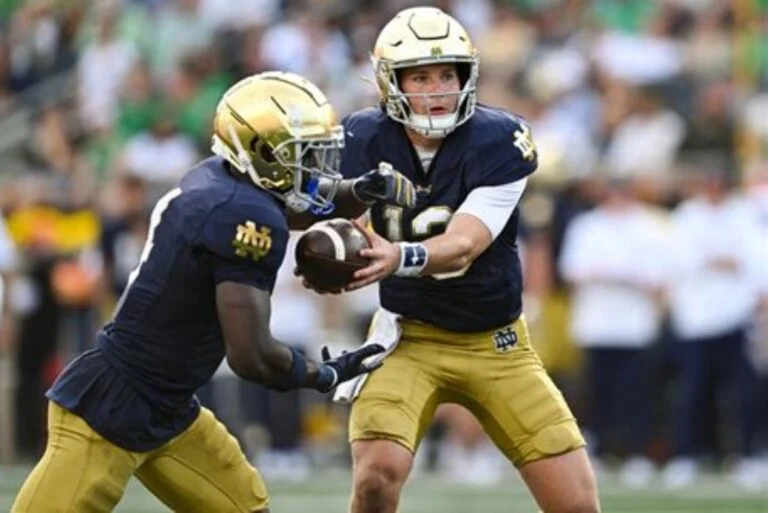Notre Dame Earns $18 Million More Than Ohio State, the College Football Playoff Winners, by Taking Advantage of a Little-Known Rule: A Look at Money Margins in College Football
In the world of college football, the race for national championships often takes center stage, with teams vying for supremacy both on the field and in the financial realm. While Ohio State’s victory in the College Football Playoff (CFP) brought immense glory and recognition to the Buckeyes, it seems that Notre Dame, which didn’t even make the final playoff cut, outpaced Ohio State financially by a stunning margin. A critical factor in this difference lies in a little-known rule that gives certain teams, including Notre Dame, a unique financial edge. This article dives into how this rule works, how it has benefited Notre Dame, and how it led to the team earning $18 million more than the CFP winners.
The Financial Battle of College Football
At the heart of the college football system, particularly when it comes to the College Football Playoff, is the financial component. College football has evolved from a regional sport to a massive business venture that includes sponsorships, media deals, ticket sales, merchandise, and, most importantly, the television rights associated with the biggest games. The teams that make the College Football Playoff generate substantial revenue for their conferences and for themselves, but not all teams are positioned the same when it comes to maximizing these financial opportunities.
For Ohio State, a powerhouse in college football, the prestige of making the College Football Playoff can seem like the ultimate achievement. And while the Buckeyes did indeed win the 2025 CFP National Championship, a deeper look into the finances reveals an interesting disparity between them and other programs like Notre Dame.
Notre Dame’s financial advantage comes from a unique status in college football: their independent status. Unlike Ohio State, which plays in the Big Ten Conference, Notre Dame is an independent school that does not belong to any specific athletic conference. This independence plays a pivotal role in how revenue is generated and distributed, and it is this independence that allowed Notre Dame to out-earn Ohio State by a substantial $18 million.
Understanding the CFP Revenue Distribution System
To understand why Notre Dame earned more than Ohio State despite not winning the College Football Playoff, it is essential to first examine how revenue is typically distributed among teams that make the playoff. When a team qualifies for the CFP, it is guaranteed a portion of the playoff revenue. This is usually in the form of a share allocated to the team’s conference. The conferences are responsible for distributing this money to their member schools based on how well they perform in the playoff.
In the case of Ohio State, their participation in the CFP meant that their conference, the Big Ten, would receive a portion of the revenue generated by the playoff system. However, unlike conference teams, Notre Dame, as an independent, does not share revenue with any conference. Instead, the Fighting Irish receive a more favorable financial arrangement because they do not have to split their revenue with any other institution.
For example, when Ohio State won the 2025 CFP National Championship, the Big Ten Conference as a whole shared in the financial windfall from the playoff. The conference’s revenue share was distributed among all its schools, meaning Ohio State did not receive all of the money generated by the team’s playoff success. While the amount Ohio State earned from the playoff was still substantial, a portion of it went to the Big Ten and the conference’s other member schools.
In contrast, Notre Dame, which was not in the playoff but still reaped significant benefits from its football program, earned more by virtue of its independence. The lack of a conference affiliation means that any revenue generated from their games, including the college football playoff or other special matchups, goes directly into Notre Dame’s coffers. No other institution or group of schools takes a cut of the revenue.
How Notre Dame Maximized Its Financial Advantage
To understand how Notre Dame earned $18 million more than Ohio State, we must consider the specific financial advantages tied to their independence. Notre Dame’s football program has long been one of the wealthiest in the sport, thanks to a combination of lucrative television contracts, massive fan support, and a high-profile brand. But Notre Dame’s true edge comes from how they negotiate their media deals and leverage their brand as a stand-alone entity.
- Television Contracts
One of the primary sources of revenue for college football programs is television contracts. Notre Dame has a unique advantage in this area due to its long-standing partnership with NBC. In a groundbreaking deal signed in 1991, Notre Dame agreed to an exclusive television contract with NBC, ensuring that all of the team’s home games were broadcast on the network. This contract has provided Notre Dame with a steady stream of revenue for decades, and it is widely considered one of the most lucrative deals in college football.In comparison, Ohio State, like other Big Ten teams, shares a portion of the revenue generated from the Big Ten Network, a cable channel created to broadcast conference games. While the Big Ten’s deal is certainly valuable, it is not as tailored to any individual school as Notre Dame’s exclusive NBC deal. For Notre Dame, this independent contract guarantees a larger portion of the revenue compared to teams like Ohio State that are tied to a conference agreement.
- Independence Equals Flexibility
Notre Dame’s independence also allows the school to schedule its own games. This flexibility enables them to negotiate high-profile matchups with a variety of opponents, which helps to maximize attendance and television viewership. Notre Dame is able to capitalize on its national brand by scheduling games against top-ranked teams, even if those teams are from other conferences.In contrast, Ohio State is bound to the Big Ten’s scheduling constraints. While the Big Ten is a competitive conference, the revenue generated by Ohio State’s games is somewhat limited by the conference’s shared structure. Notre Dame, on the other hand, has the freedom to select its opponents, schedule games that will generate national attention, and maximize television revenue for every game it plays.
- Fanbase and Merchandise Sales
Notre Dame has one of the most devoted fanbases in all of college football, which translates into significant merchandise sales, ticket sales, and donations. The Fighting Irish regularly fill Notre Dame Stadium, even for games that do not involve top-ranked teams. This fan loyalty ensures a steady stream of revenue, and the school has capitalized on this by expanding its brand and merchandising efforts.Ohio State, too, benefits from a massive fanbase, but the financial structure within the Big Ten limits their ability to fully capitalize on the market as Notre Dame does. Ohio State shares revenue with the rest of the conference’s teams, diluting the financial benefits of the Buckeyes’ success. Notre Dame, as an independent program, controls its own revenue streams and is able to take full advantage of its brand’s power.
The Little-Known Rule That Creates This Disparity
So, how does this all tie into the $18 million advantage for Notre Dame? The secret lies in a rule within the NCAA’s revenue distribution system that disproportionately benefits independent teams, especially those like Notre Dame with lucrative media deals.
The NCAA distributes revenue from the College Football Playoff in two ways: through automatic bids and by granting a share to the conferences. When a team earns a spot in the playoff, its conference gets a portion of the revenue. However, independent teams like Notre Dame are able to claim the entirety of their playoff-generated revenue, without having to share it with a conference. This rule effectively allows Notre Dame to earn more money from the playoff than teams in conferences like the Big Ten, which are subject to revenue-sharing agreements.
In essence, the financial structure rewards Notre Dame for maintaining its independent status, providing them with a larger financial cushion than Ohio State, which may have won the National Championship but faced the financial constraints of being part of a conference.
Conclusion: A Clear Example of Financial Strategy at Play
While Ohio State’s triumph in the 2025 College Football Playoff cemented its place in college football history, Notre Dame demonstrated that in the world of college football, financial success can be just as significant as on-field victory. Through a combination of television contracts, independent scheduling, fan support, and a little-known rule that favors independent teams, Notre Dame out-earned Ohio State by an astounding $18 million.
In the future, this financial edge could prove to be a major factor in recruiting, facilities, and long-term sustainability for both programs. The interplay between athletics and finance continues to shape the future of college football, and for Notre Dame, this unique advantage has paid off in a big way.



